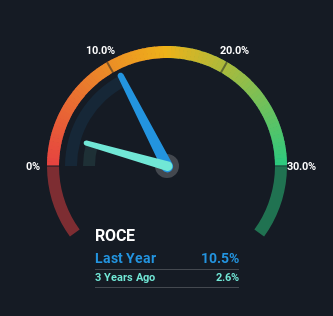- South Korea
- /
- Personal Products
- /
- KOSDAQ:A234690
GREEN CROSS WellBeing (KOSDAQ:234690) May Have Issues Allocating Its Capital

To find a multi-bagger stock, what are the underlying trends we should look for in a business? Typically, we'll want to notice a trend of growing return on capital employed (ROCE) and alongside that, an expanding base of capital employed. Ultimately, this demonstrates that it's a business that is reinvesting profits at increasing rates of return. However, after investigating GREEN CROSS WellBeing (KOSDAQ:234690), we don't think it's current trends fit the mold of a multi-bagger.
Understanding Return On Capital Employed (ROCE)
For those who don't know, ROCE is a measure of a company's yearly pre-tax profit (its return), relative to the capital employed in the business. The formula for this calculation on GREEN CROSS WellBeing is:
Return on Capital Employed = Earnings Before Interest and Tax (EBIT) ÷ (Total Assets - Current Liabilities)
0.10 = ₩11b ÷ (₩164b - ₩57b) (Based on the trailing twelve months to March 2024).
Therefore, GREEN CROSS WellBeing has an ROCE of 10%. That's a relatively normal return on capital, and it's around the 9.2% generated by the Personal Products industry.
Check out our latest analysis for GREEN CROSS WellBeing

While the past is not representative of the future, it can be helpful to know how a company has performed historically, which is why we have this chart above. If you're interested in investigating GREEN CROSS WellBeing's past further, check out this free graph covering GREEN CROSS WellBeing's past earnings, revenue and cash flow.
What Can We Tell From GREEN CROSS WellBeing's ROCE Trend?
When we looked at the ROCE trend at GREEN CROSS WellBeing, we didn't gain much confidence. Around five years ago the returns on capital were 25%, but since then they've fallen to 10%. Although, given both revenue and the amount of assets employed in the business have increased, it could suggest the company is investing in growth, and the extra capital has led to a short-term reduction in ROCE. If these investments prove successful, this can bode very well for long term stock performance.
On a side note, GREEN CROSS WellBeing's current liabilities have increased over the last five years to 35% of total assets, effectively distorting the ROCE to some degree. Without this increase, it's likely that ROCE would be even lower than 10%. While the ratio isn't currently too high, it's worth keeping an eye on this because if it gets particularly high, the business could then face some new elements of risk.
The Bottom Line
While returns have fallen for GREEN CROSS WellBeing in recent times, we're encouraged to see that sales are growing and that the business is reinvesting in its operations. These trends don't appear to have influenced returns though, because the total return from the stock has been mostly flat over the last five years. As a result, we'd recommend researching this stock further to uncover what other fundamentals of the business can show us.
One more thing to note, we've identified 1 warning sign with GREEN CROSS WellBeing and understanding this should be part of your investment process.
If you want to search for solid companies with great earnings, check out this free list of companies with good balance sheets and impressive returns on equity.
If you're looking to trade GREEN CROSS WellBeing, open an account with the lowest-cost platform trusted by professionals, Interactive Brokers.
With clients in over 200 countries and territories, and access to 160 markets, IBKR lets you trade stocks, options, futures, forex, bonds and funds from a single integrated account.
Enjoy no hidden fees, no account minimums, and FX conversion rates as low as 0.03%, far better than what most brokers offer.
Sponsored ContentNew: Manage All Your Stock Portfolios in One Place
We've created the ultimate portfolio companion for stock investors, and it's free.
• Connect an unlimited number of Portfolios and see your total in one currency
• Be alerted to new Warning Signs or Risks via email or mobile
• Track the Fair Value of your stocks
Have feedback on this article? Concerned about the content? Get in touch with us directly. Alternatively, email editorial-team (at) simplywallst.com.
This article by Simply Wall St is general in nature. We provide commentary based on historical data and analyst forecasts only using an unbiased methodology and our articles are not intended to be financial advice. It does not constitute a recommendation to buy or sell any stock, and does not take account of your objectives, or your financial situation. We aim to bring you long-term focused analysis driven by fundamental data. Note that our analysis may not factor in the latest price-sensitive company announcements or qualitative material. Simply Wall St has no position in any stocks mentioned.
About KOSDAQ:A234690
GREEN CROSS WellBeing
Provides personalized nutrition injections in South Korea.
Excellent balance sheet second-rate dividend payer.
Market Insights
Community Narratives



